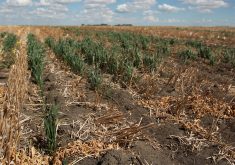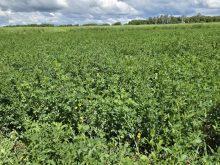Meteorologists believe an El Nino is replacing La Nina, but the dryness associated with La Nina will be felt for a while yet
The U.S. National Ocean and Atmospheric Administration predicts there is almost a 50 percent chance an El Nino weather event will emerge this growing season.
That is slightly higher odds than neutral El Nino Southern Oscillation conditions.
Drew Lerner, president of World Weather Inc., said the transition to El Nino will have little impact on Canadian Prairie weather.
He thinks North America will deal with La Nina’s footprint for another few months even though it has technically faded away.
“It was such a significant event for such a long time that it will take a while for the atmosphere to relax to a more normal state,” said Lerner.
That means the drought in portions of the western Prairies will persist into the start of the growing season.
But there could be some random storm activity.
“The atmosphere has to scramble to try to get from one phase to the other,” he said.
“There’s going to be lots of little eddies of anomalous weather.”
The ridge of high pressure over British Columbia and Alberta that will cause the initial spring dryness is expected to break and move east in June.
That should bring welcome rain to much of the parched areas of the western prairie region during summer.
One analog year that Lerner is looking at suggests a very wet summer is possible.
“A lot of times when you break a serious drought you do go to the other extreme,” he said.
But that is not what he predicts. There should be ample summer rain but it won’t be a deluge.
Those summer rains will dip into the northern plains region of the United States.
Lerner also expects some decent rainfall in the hard red winter wheat area of the U.S. Plains in late March and April as La Nina’s influence dissipates.
There will also be timely rains in the U.S. Midwest.
But as the country moves into summer, a ridge of high pressure will reappear in the plains region, resulting in a return to dry conditions for that area.
Mark Brusberg, chief meteorologist with the U.S. Department of Agriculture, believes farmers in the U.S. are in the midst of a megadrought.
There have been five multi-year La Nina events since 1990, including the three-year event that just ended.
“This is pretty unusual,” he told delegates attending the USDA’s 99th Annual Agricultural Outlook Forum.
“That’s a lot of multi-year events.”
Megadroughts have occurred in the late 800s, mid-1100s, late 1200s, and the late 1500s.
He believes what the U.S. is experiencing in the early 2000s is quite likely the next one.
“We might be seeing something in the ENSO record that we haven’t seen in three or four hundred years,” said Brusberg.
There are plenty of telltale signs.

The water level in Nevada’s and Arizona’s Lake Mead is 51 metres below where it was at the start of this century. The lake is at a point where it would no longer be generating electricity had the Hoover Dam not been upgraded.
Water levels at Lake Powell are so low that the U.S. government is taking “urgent drought response actions,” drawing water from other reservoirs.
“It’s pretty sobering that we’re having to take these drastic measures,” said Brusberg.
The prolonged drought is causing a downsizing of the U.S. cattle herd.
The megadrought is also affecting Argentina.
Temperatures in the central part of the country, which is the high-yielding corn and soybean region, have often averaged .5 to 1.5 C above normal for the Dec. 1 to Feb. 14 period since 2010.
There have also been many years where the maximum temperature in that region exceeded 34 C for five to 15 days during the Dec. 15 to Jan. 15 period when Argentina’s first corn crop is in the reproductive phase.
Farmers have adapted by switching to lower-yielding second crop corn like their neighbours in Brazil.
Brusberg said the switch to El Nino conditions should bring some relief to Argentina’s growers.
“In the years after La Nina they tend to rebound,” he said.
“In some years they’ve had record yields after several poor years.”


















